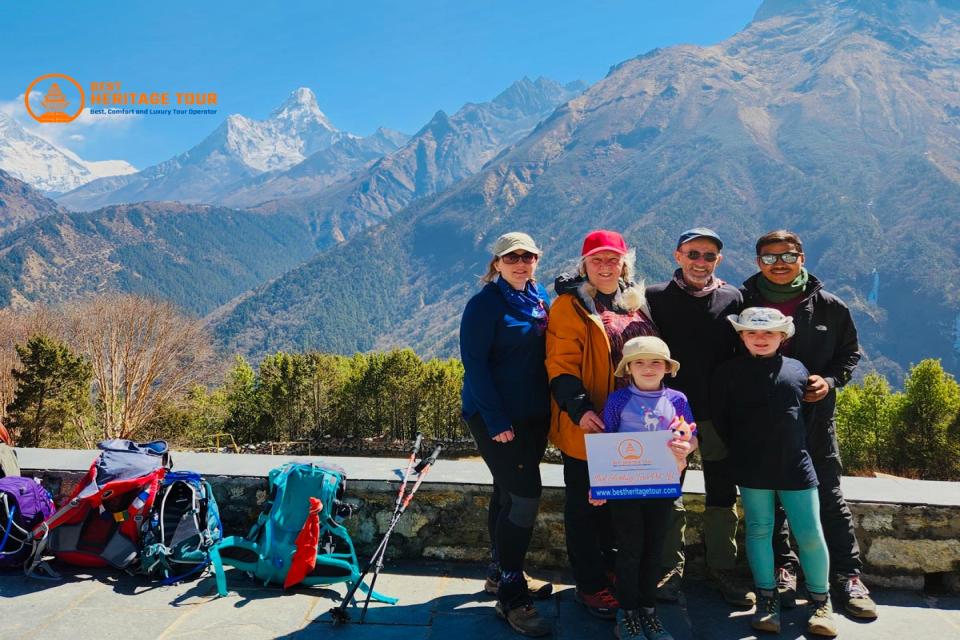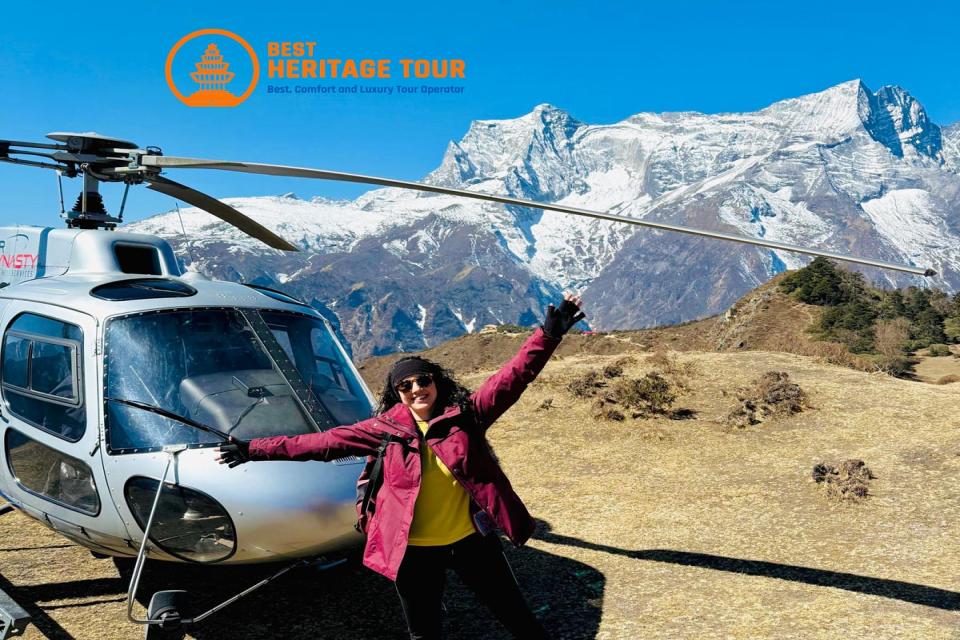Few experiences on Earth can rival the magic of standing at the foot of Mount Everest - the tallest mountain in the world. The Everest Base Camp Trek (EBC Trek) is not just a journey through rugged Himalayan terrain; it is an adventure through Nepal’s rich culture, history, and natural beauty.
If you are planning your Everest Base Camp Trek in May, you have chosen one of the most ideal months of the year to experience this world-famous trek. May marks the end of Nepal’s spring season, offering mild temperatures, clear skies, vibrant rhododendron blooms, and breathtaking mountain views.
In this detailed guide, crafted by the team at Best Heritage Tour, we will take you through everything you need to know about trekking to Everest Base Camp in May - from weather and packing to permits, route details, altitude, preparation, and practical travel tips.
Why Trek to Everest Base Camp in May?
May is considered one of the best months to trek in the Everest region. The combination of pleasant weather, good visibility, and vibrant Himalayan life makes it an unbeatable time to experience the world’s most iconic trekking route.
Here’s why May is an excellent choice:
-
Stable Weather: The skies are generally clear, and the temperatures are moderate, neither too hot nor too cold.
-
Best Mountain Views: The Himalayan peaks - including Everest (8,848.86m), Lhotse, Nuptse, Ama Dablam, and Thamserku - are often visible in full glory.
-
Blooming Rhododendrons: May is the last month of spring, and the forests are still alive with rhododendrons, Nepal’s national flower.
-
Festive Atmosphere: Local Sherpa villages are bustling with trekkers, making for a lively and cultural experience.
-
Perfect Acclimatization Conditions: With moderate temperatures and predictable weather, your body adjusts better to the altitude.
Everest Base Camp Trek Overview
-
Destination: Everest Base Camp (5,364 metres)
-
Starting Point: Lukla (2,860 metres)
-
Ending Point: Lukla
-
Total Duration: 12-14 days (standard)
-
Best Month: May
-
Trek Difficulty: Moderate to Challenging
-
Accommodation: Teahouse/Lodge
-
Permits Required: Sagarmatha National Park Permit, Khumbu Pasang Lhamu Rural Municipality Permit
Weather and Temperature in May
May marks the tail end of the spring trekking season, just before the onset of the monsoon in mid-June. The weather is generally dry and clear in the first half of May, while light showers might appear towards the end of the month.
Temperature Overview:
-
Lukla (2,860m): 5°C - 18°C
-
Namche Bazaar (3,440m): 2°C - 15°C
-
Dingboche (4,410m): -3°C - 12°C
-
Everest Base Camp (5,364m): -8°C - 6°C
Days are warm enough for comfortable trekking in light layers, while evenings and nights can still be quite chilly at higher altitudes. Early morning views tend to be the clearest, with crystal-blue skies and panoramic Himalayan vistas.
How to Get to Everest Base Camp
The journey to Everest Base Camp begins with a scenic flight from Kathmandu to Lukla, one of the most thrilling short flights in the world. From there, the trek continues northwards through the Khumbu Valley.
Typical Route Itinerary (14 Days)
-
Day 1: Fly Kathmandu to Lukla (2,860m), trek to Phakding (2,610m)
-
Day 2: Trek to Namche Bazaar (3,440m)
-
Day 3: Acclimatisation Day in Namche Bazaar
-
Day 4: Trek to Tengboche (3,860m)
-
Day 5: Trek to Dingboche (4,410m)
-
Day 6: Acclimatisation Day in Dingboche
-
Day 7: Trek to Lobuche (4,910m)
-
Day 8: Trek to Everest Base Camp (5,364m) via Gorak Shep (5,140m)
-
Day 9: Hike to Kala Patthar (5,545m) for sunrise views, trek back to Pheriche (4,240m)
-
Day 10: Trek to Namche Bazaar
-
Day 11: Trek to Lukla
-
Day 12: Fly back to Kathmandu
This classic itinerary allows for two proper acclimatization days and gradual altitude gain, minimizing the risk of altitude sickness.
Permits Required for EBC Trek
To trek to Everest Base Camp, you need two key permits:
-
Sagarmatha National Park Entry Permit
-
Cost: NPR 3,000 per person (approx. USD 25)
-
Obtainable in Kathmandu or Monjo (entrance of the park).
-
-
Khumbu Pasang Lhamu Rural Municipality Permit
-
Cost: NPR 2,000 per person (approx. USD 15-20)
-
Obtainable at Lukla or Monjo checkpoint.
-
If you’re trekking through a registered agency like Best Heritage Tour, all permits will be arranged for you beforehand.
Difficulty Level and Physical Preparation
The Everest Base Camp Trek is considered moderately challenging. It doesn’t require technical climbing skills, but you should have good physical fitness and stamina for long days of trekking - typically 5-7 hours per day on steep and uneven terrain.
Training Tips:
-
Begin physical training at least 8-10 weeks before the trek.
-
Include cardio exercises like hiking, jogging, cycling, and stair climbing.
-
Focus on leg strength, endurance, and flexibility.
-
If possible, take short hikes carrying a backpack to simulate trekking conditions.
Altitude and Acclimatization
Altitude sickness can affect anyone above 2,500 metres. Proper acclimatisation is crucial for a safe and successful trek.
Tips to Prevent Altitude Sickness:
-
Ascend gradually and avoid rushing.
-
Stay hydrated (3-4 liters of water daily).
-
Avoid alcohol and smoking during the trek.
-
Take acclimatization days seriously - explore around Namche Bazaar and Dingboche.
-
Use medication like Diamox (consult your doctor beforehand).
Remember, the key to success on this trek is “climb high, sleep low.”
Accommodation and Meals
Teahouse trekking is one of the most charming aspects of the EBC experience. Local lodges provide cozy rooms, hearty meals, and warm hospitality.
Accommodation:
-
Basic twin-sharing rooms with shared bathrooms are common.
-
Hot showers, Wi-Fi, and charging are available at most places for a small extra cost.
-
Blankets are provided, but carrying your own sleeping bag is recommended.
Meals:
-
Common dishes include Dal Bhat (rice and lentils), noodles, momo, pasta, potatoes, and soups.
-
For breakfast, expect porridge, pancakes, eggs, or Tibetan bread.
-
Vegetarian options are widely available and often recommended at higher altitudes for easier digestion.
What to Pack for Everest Base Camp Trek in May
Packing smartly can make your trek much more comfortable. May’s weather demands a mix of light layers for daytime and warm clothing for higher altitudes.
Essential Packing List
Clothing:
-
2-3 moisture-wicking T-shirts
-
2 pairs of trekking trousers
-
1 fleece jacket
-
1 down jacket (for higher altitudes)
-
1 waterproof/windproof jacket
-
Thermal base layers (top and bottom)
-
Trekking socks (4-5 pairs)
-
Warm hat, gloves, and buff
-
Sunglasses and sun hat
Footwear:
-
Sturdy, broken-in trekking boots
-
Lightweight sandals for evenings
Accessories:
-
Day backpack (30-40L)
-
Duffel bag (carried by porter)
-
Reusable water bottle or hydration bladder
-
Trekking poles
-
Headlamp with extra batteries
Other Essentials:
-
Sunscreen, lip balm, and personal first aid kit
-
Water purification tablets
-
Toilet paper and wet wipes
-
Power bank and universal adapter
-
Copies of passport and permits
Flora, Fauna, and Himalayan Culture
The Everest region is not just about mountains - it’s a living cultural and natural treasure.
Flora:
May is one of the most beautiful months to witness rhododendron forests, juniper trees, and alpine meadows in full bloom.
Fauna:
With luck, you might spot Himalayan tahrs, musk deer, snow pigeons, or even danphe (Nepal’s national bird).
Culture:
The trail passes through Sherpa villages like Namche, Khumjung, and Pangboche, where colourful prayer flags, Buddhist stupas, and ancient monasteries showcase the deep spirituality of the region.
A visit to Tengboche Monastery offers not only a spiritual experience but also one of the best panoramic views of the Everest range.
Internet, Electricity, and Connectivity
While you are trekking in the Himalayas, you won’t be completely disconnected.
-
Electricity: Available in most lodges, powered by solar or hydro systems. Charging costs NPR 200-400 per device.
-
Wi-Fi: Available in Namche, Dingboche, and some higher villages via the Everest Link card (purchase required).
-
Mobile Networks: Ncell and NTC SIMs offer intermittent service up to Gorak Shep, but reliability decreases with altitude.
Travel Insurance
It’s essential to have comprehensive travel insurance that covers:
-
High-altitude trekking (up to 6,000 metres)
-
Emergency evacuation by helicopter
-
Medical treatment and trip cancellation
Always carry a copy of your insurance policy and emergency contact details during the trek.
Booking Your EBC Trek for May
As May is one of the most popular months, early booking is highly recommended. Flights to Lukla and quality teahouse accommodation get reserved quickly.
Booking with a trusted local company like Best Heritage Tour ensures a well-organized, safe, and culturally immersive experience - from permit handling to guide arrangements, logistics, and emergency support.
Tips for Trekking in May
-
Start early each morning to enjoy clear views before the clouds roll in.
-
Pack a lightweight rain jacket in case of occasional afternoon showers.
-
Apply sunscreen frequently; UV rays are strong at high altitudes.
-
Drink plenty of water and eat nourishing meals to maintain energy.
-
Be flexible with your itinerary if weather conditions affect flights to or from Lukla.
Conclusion - Your Himalayan Dream Awaits
The Everest Base Camp Trek in May promises an unforgettable journey through the heart of the Himalayas. The weather, scenery, and cultural richness make it the perfect month to realise your dream of standing beneath the mighty Everest.
Whether you are an avid trekker or a first-time adventurer, this trek will test your spirit, inspire your soul, and leave you with stories to cherish for a lifetime.
Start planning your adventure today with Best Heritage Tour - your trusted Nepal-based trekking expert.
Contact Best Heritage Tour
Phone / WhatsApp / Viber: +977-9851149197 / +977-9810043046
Email: info@bestheritagetour.com / bestheritagetour@gmail.com
Website: www.bestheritagetour.com
Office: Thamel Marg, Kathmandu, Nepal
Author: Best Heritage Tour
Date: 10th November, 2025







